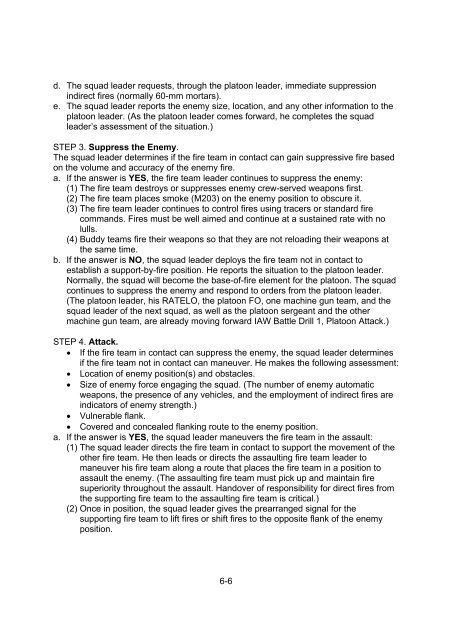Create successful ePaper yourself
Turn your PDF publications into a flip-book with our unique Google optimized e-Paper software.
d. The squad leader requests, through the platoon leader, immediate suppression<br />
indirect fires (normally 60-mm mortars).<br />
e. The squad leader reports the enemy size, location, and any other information to the<br />
platoon leader. (As the platoon leader comes forward, he completes the squad<br />
leader’s assessment of the situation.)<br />
STEP 3. Suppress the Enemy.<br />
The squad leader determines if the fire team in contact can gain suppressive fire based<br />
on the volume and accuracy of the enemy fire.<br />
a. If the answer is YES, the fire team leader continues to suppress the enemy:<br />
(1) The fire team destroys or suppresses enemy crew-served weapons first.<br />
(2) The fire team places smoke (M203) on the enemy position to obscure it.<br />
(3) The fire team leader continues to control fires using tracers or standard fire<br />
commands. Fires must be well aimed and continue at a sustained rate with no<br />
lulls.<br />
(4) Buddy teams fire their weapons so that they are not reloading their weapons at<br />
the same time.<br />
b. If the answer is NO, the squad leader deploys the fire team not in contact to<br />
establish a support-by-fire position. He reports the situation to the platoon leader.<br />
Normally, the squad will become the base-of-fire element for the platoon. The squad<br />
continues to suppress the enemy and respond to orders from the platoon leader.<br />
(The platoon leader, his RATELO, the platoon FO, one machine gun team, and the<br />
squad leader of the next squad, as well as the platoon sergeant and the other<br />
machine gun team, are already moving forward IAW Battle Drill 1, Platoon Attack.)<br />
STEP 4. Attack.<br />
• If the fire team in contact can suppress the enemy, the squad leader determines<br />
if the fire team not in contact can maneuver. He makes the following assessment:<br />
• Location of enemy position(s) and obstacles.<br />
• Size of enemy force engaging the squad. (The number of enemy automatic<br />
weapons, the presence of any vehicles, and the employment of indirect fires are<br />
indicators of enemy strength.)<br />
• Vulnerable flank.<br />
• Covered and concealed flanking route to the enemy position.<br />
a. If the answer is YES, the squad leader maneuvers the fire team in the assault:<br />
(1) The squad leader directs the fire team in contact to support the movement of the<br />
other fire team. He then leads or directs the assaulting fire team leader to<br />
maneuver his fire team along a route that places the fire team in a position to<br />
assault the enemy. (The assaulting fire team must pick up and maintain fire<br />
superiority throughout the assault. Handover of responsibility for direct fires from<br />
the supporting fire team to the assaulting fire team is critical.)<br />
(2) Once in position, the squad leader gives the prearranged signal for the<br />
supporting fire team to lift fires or shift fires to the opposite flank of the enemy<br />
position.<br />
6-6


